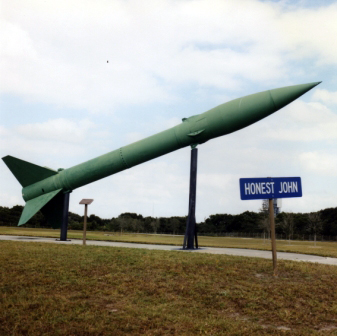
Overview
Retired Exhibit
- Type: Surface-to-surface artillery rocket
- Designation: M-50 / MGR-1
- Payload: Conventional or nuclear warhead
- Agency: U.S. Army
- Contractor: Douglas Aircraft Company
History
What eventually became the Honest John field artillery rocket began as a Jet-Assisted Take-Off (JATO) booster for aircraft. Since the JATO had a high thrust level, it was decided that the addition of fins and a warhead would create a potent weapon.
U.S. Army Ordnance officials outlined specifications for a large-caliber artillery rocket in the early 1950’s. Since a powerful JATO rocket existed, Douglas Aircraft submitted a proposal for a test version within one month of system conception. Initial tests were completed by August 1951 with justification for subsequent production models of the rocket.
Rocket Design
Sometimes referred to as a 762-millimeter rocket, Honest John was quite uncomplicated in design and operation. It had no electronic controls and required no extensive crew training. The same firing doctrine used in firing conventional artillery was adopted for the Honest John. The absence of any electronic or radio guidance of the Honest John made it impossible for the enemy to alter its course.
In cold weather, Honest John rockets were outfitted with a form fitting “electronic blanket ‘to maintain the specific propellant temperature for launch. Because of its size and simplicity, Honest John had considerably more battlefield mobility than conventional artillery. Just one nuclear warhead carried aboard an Honest John could deliver the destructive power of hundreds of artillery shells.